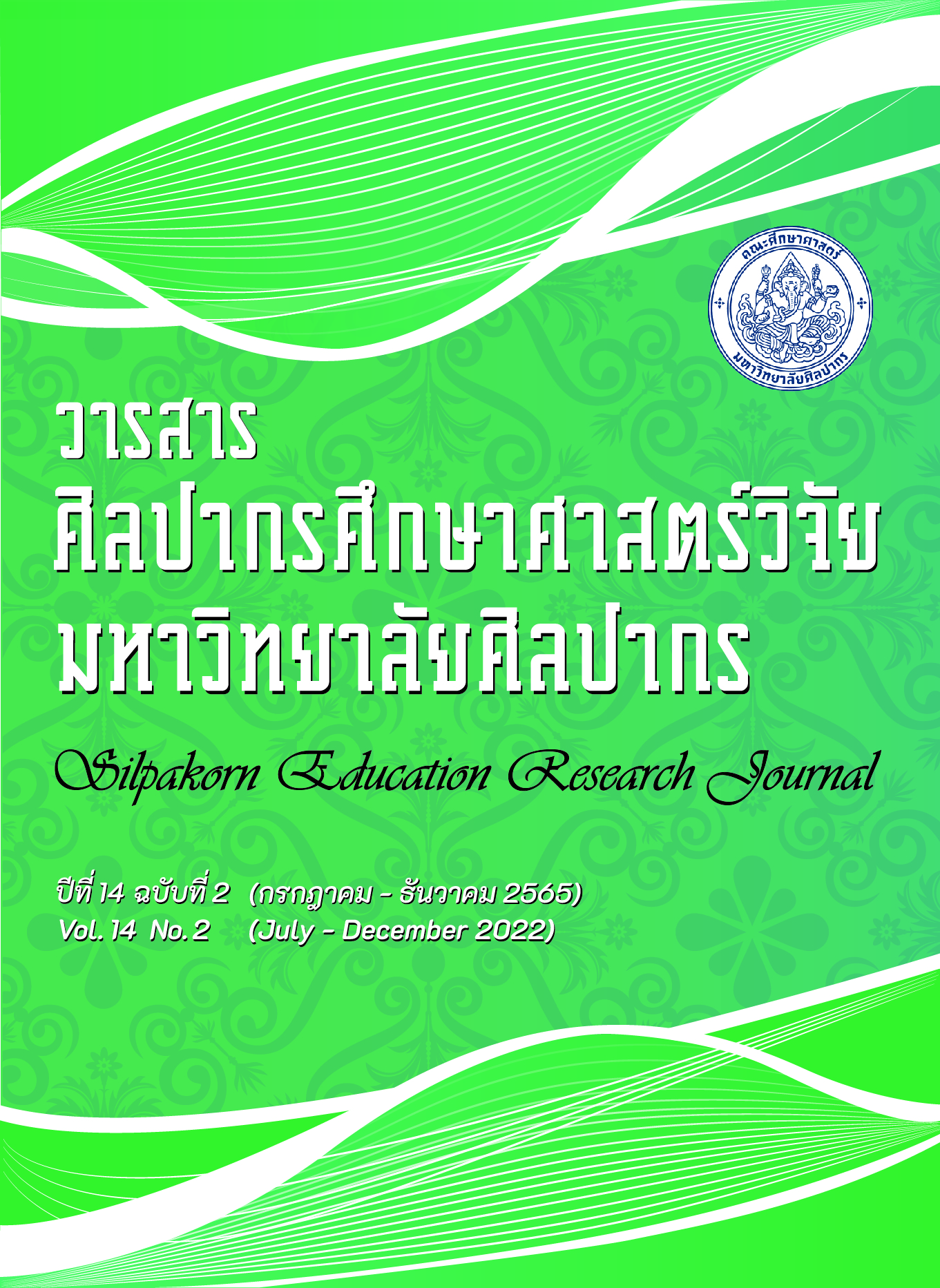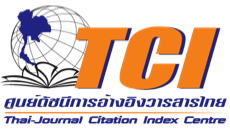ตัวแบบการจัดการเรียนรู้เพื่อพัฒนาทักษะการเรียนรู้และนวัตกรรม ของนักเรียนโรงเรียนสาธิต ระดับมัธยมศึกษา จังหวัดนครปฐม (Learning Management Model for Learning and Innovation Skills Development of Students Demonstration Secondary School, Nakhon Pathom Province)
คำสำคัญ:
การจัดการเรียนรู้, ทักษะการเรียนรู้และนวัตกรรม, โรงเรียนสาธิตมัธยมศึกษา นครปฐมบทคัดย่อ
ทักษะการเรียนรู้และนวัตกรรม เป็นทักษะที่จำเป็นต่อการพัฒนาทรัพยากรมนุษย์ งานวิจัยนี้จึงมีวัตถุประสงค์เพื่อศึกษาตัวแบบการจัดการเรียนรู้เพื่อพัฒนาทักษะการเรียนรู้และนวัตกรรมของนักเรียนโรงเรียนสาธิต ระดับมัธยมศึกษา จังหวัดนครปฐม ผู้ให้ข้อมูลหลักคือ ผู้บริหาร ครู ผู้ปกครอง และนักเรียนโรงเรียนสาธิตระดับมัธยมศึกษาในจังหวัดนครปฐม จำนวน 15 คน เครื่องมือที่ใช้ในการวิจัยคือ แนวคำถามสำหรับการสัมภาษณ์ระดับลึกและการสนทนากลุ่ม การวิเคราะห์ข้อมูลใช้การสร้างทฤษฎีฐานรากผลการวิจัย พบว่า 1. การจัดการเรียนรู้เพื่อพัฒนาทักษะการเรียนรู้และนวัตกรรม ประกอบด้วย การศึกษาศักยภาพและความต้องการของผู้เรียน การกระตุ้นการตั้งคำถามและการอภิปราย การวางแผนการจัดกิจกรรมการเรียนรู้ การจัดกิจกรรมการเรียนรู้ให้เชื่อมโยงกลุ่มสาระวิชา การใช้การวิจัยและวิธีการสอนหลายรูปแบบ และการประเมินหลายมุมมอง 2. เงื่อนไขความสำเร็จในการจัดการเรียนรู้เพื่อพัฒนาทักษะการเรียนรู้และนวัตกรรม ประกอบด้วย 2.1 สถานศึกษากำหนดวิสัยทัศน์และอัตลักษณ์ที่สนับสนุนการเรียนรู้และนวัตกรรม 2.2 มาตรฐานการศึกษาที่มีตัวบ่งชี้ที่สนับสนุนความคิดสร้างสรรค์ นวัตกรรม การจัดการเรียนรู้ และการวิจัย 2.3 ผู้สอนจัดการเรียนรู้โดยการปฏิบัติจริงเพื่อสร้างประสบการณ์ การใช้การวิจัยเพื่อพัฒนานวัตกรรมทางการศึกษา การแลกเปลี่ยนเรียนรู้ระหว่างผู้สอนเพื่อสะท้อนกลับข้อมูลในการพัฒนาผู้เรียน และการประเมินผลการเรียนรู้หลากหลายวิธี 2.4 ผู้เรียนมีทักษะที่จำเป็นต่อการเรียนรู้และนวัตกรรม การเรียนรู้อย่างมีส่วนร่วม การอภิปรายและแสดงความคิดเห็น การยอมรับความแตกต่างทางความคิด การเรียนรู้จากการปฏิบัติงานร่วมกัน 2.5 สภาพแวดล้อมการเรียนรู้ทั้งทางกายภาพและทางสังคม ที่สนับสนุนการจัดการเรียนรู้ร่วมกันระหว่างกลุ่มสาระวิชา รวมทั้งหน่วยงานภายในและภายนอกสถานศึกษา และ 2.6 เครือข่ายความร่วมมือเพื่อสนับสนุนทรัพยากรทางการศึกษา ทั้งโรงเรียนสาธิต คณะในมหาวิทยาลัย และหน่วยงานภายนอก
เอกสารอ้างอิง
Akinoglu, O., and Tandogn, R. (2006). The effects of problem – based active learning in
Science education on students’ academic achievement, attitude and
concept learning. [Online]. Retrieved April, 29, 2020, from
http://www.ejmste.com/v3n1/EJMSTEv3n1_Akinoglu
Ashley L. M., Neil A. K., and Kathryn, S.O. (2015). “Exploring the Effects of Active Learning on
High School Students’ Outcomes and Teachers’ Perceptions of Biotechnology and
Genetics Instruction”. Journal of Agricultural Education 56(138-152): 138-149.
Bonwell, C.C. (2003). Active Learning: Creating Excitement in the Classroom. [Online].
Retrieved April, 29, 2020, from www.active-learning-site.com
Chantaranamchoo, N., Polpanthin, Y., and Laophuangsak, P. (2019). “The Western Region Schools’ Learning Management Model Development for Student Quality Development in Accordance with the Basic Educational Standards.” Veridian E-Journal, Silpakorn University 12(2): 758-774. (in Thai)
Chantaranamchoo, N. and Sukjairungwattana,T. (2018). “Guidelines for Professional Skills of
Students from the Institute of Vocational Education: Central Region 4 for Human Development towards Thailand 4.0.” Veridian E-Journal, Silpakorn University 11(1): 2843-2859. (in Thai)
Comia, A., and Ryan, C. (2006). Creative Movement: A Powerful Strategy to Teach Science.
[Online]. Retrieved April, 29, 2020, from
http://openlibrary.org/b/OL21549770M/Creative_moverment_A_powerful_
strategy_to_teach_science
Corbin, J.M., and Strauss, A.L. (2008). Basics of Qualitative Research: Techniques and Procedures for Developing Grounded Theory. 3rd ed. Sage Publication, Inc: London.
enGauge. (2003). 21st Century Skills for 21st Century Learners. [Online]. Retrieved May, 20,
, from https://pict.sdsu.edu/engauge21st.pdf
Felder, R.M. (2022). Teaching and Learning STEM. [Online]. Retrieved May, 20, 2020, from
https://www.engr.ncsu.edu/stem-resources/legacy-site/learner-centered/
Fusch, P., Fusch, G.E., and Ness L.R. (2018). Denzin’ s paradigm shift: Revisiting
triangulation in qualitative. Journal of Social Change 10(1): 19-32.
Garner, D.L. (2012). The Acquisition of Cultural Competence: A Phenomenological
Inquiry Highlighting the Processes, Challenges and Triumphs of Counselor
Education Student. University of Nevada, United States.
Hurt, J.A., Thibodeau, S.A., Hirsh, A.S., Pabo, C.O., and Joung, J.K. (2003). “Highly specific
zinc finger proteins obtained by directed domain shuffling and cell-based
selection.” Proc. Natl. Acad. Sci. Unit. States Am 100(21): 12271-12276.
International Society for Technology in Education Students. (2007). ISTE students
standards. [Online]. Retrieved May, 20, 2017, from https://www.iste.org/docs/pdfs/20-14_ISTE_Standards-S_PDF.pdf
Kasetsart University Demonstration School Kamphaeng Saen Campus. (2020). Educational
Institutions According to the Core Course of Basic Education Year 2008. Nakhon
Pathom. (in Thai)
Lock, L., & Natalie, N. (2020). “Applying partial least squares structural equation
modeling (PLS-SEM) in an investigation of undergraduate students’ learning
transfer of academic English.” Journal of English for Academic Purposes 46. 100884.
Lynch, D.E. (2012). Preparing Teachers in Times of Change: Teaching Schools, New Content and Evidence. Tarragindi: Primrose Hall Publishing Group.
Maya, U., Miri, B., and Hossam, H. (2021). “Online vs. on-campus higher education:
Exploring innovation in students' self-reports and students' learning products.”
Thinking Skills and Creativity. 42. 100965.
Office of the National Economic and Social Development Board. (2016). National Economic
and Social Development Plan No.12 (2017-2021). Bangkok: Office of the National
Economic and Social Development Board. (in Thai)
Office of the National Economic and Social Development. (2019). Master Plan under the
National Strategy (23) Research and Development of Innovation (2018 - 2037).
[Online]. Retrieved from Jan, 20, 2020 from shorturl.at/eqKW0 (in Thai)
Shenker, J.I., Goss, S.A., and Bernstein, D.A. (1996). Instructor’s Resource Manual for
Psychology: Implementing Active Learning in the Classroom. [Online]. Retrieved Jan, 5, 2020, from http://s.psych/uiuc,edu/~jskenker/active.html.
Sliwka, A. (2003). Networking for Educational Innovation: A Comparative Analysis,
Published in Networks of Innovation, OECD/CERI. [Online]. Retrieved October, 1, 2014, from shorturl.at/qFKL0
Smith, R., and Lynch, S. (2010). Rethinking Teacher Education: Teacher Education in the Knowledge Age. Sydney: AACLM Press.
Stanford Teaching Commons. (2015). Course Design Overview. [Online]. Retrieved Jan, 5, 2020,
from https://teachingcommons.stanford.edu
Thailand Development Research Institute. (2014). The Preparation of Basic Education
Reform Strategies to Create Accountability. Thailand Development Research
Institute: Bangkok. (in Thai)
The Demonstration School of Nakhon Pathom Rajabhat University. (2020). Philosophy,
Vision, Mission. [Online]. Retrieved Jan, 20, 2020, from http://st.npru.ac.th/index.php/login/2014-05-29-06-26-44 (in Thai)
The Demonstration School of Silpakorn University. (2020). Philosophy, Vision,
Mission. [Online]. Retrieved Jan, 20, 2020, from
http://www.satit.su.ac.th/home/index.php/2017-05-31-04-41-62/2017-07-02-04-09-39
(in Thai)
The Partnership for 21st Century Learning (2017). Framework for 21st Century
Learning. [Online]. Retrieved May, 20, 2017, from, http://www.p21.org/our-work/p21-
framework.
Wood, K. (2008). “Mathematics through Movement: An Investigation of the Links between
Kinaesthetic and Conceptual Learning”. Australian Primary Mathematics Classroom
(1): 18-22.





